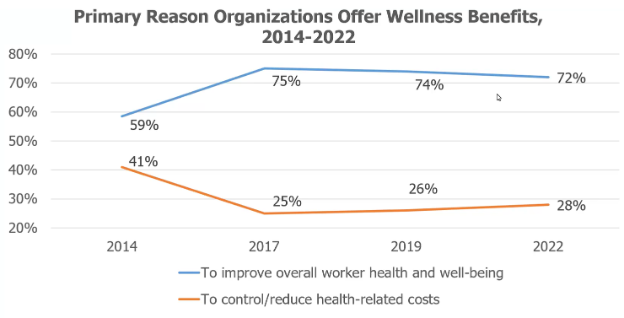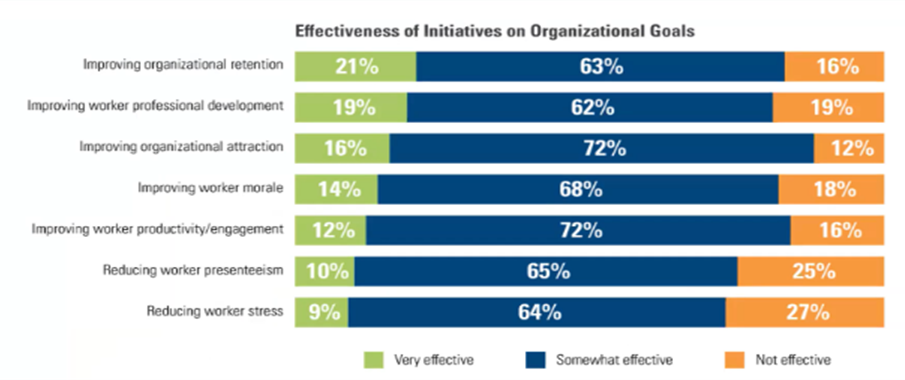2025 Workplace Wellness and Financial Education Survey: Key Takeaways

Workplace wellness programs have grown to include benefits that address workers' mental health, financial health, growth, and purpose. In a recent webcast, Ryan Picarella, executive director for the Wellness Alliance, and Justin M. Held, associate director of research and education for the International Foundation of Employee Benefit Plans, presented findings from the Workplace Wellness and Financial Education: 2025 Survey Report, revealing details about current initiatives and insights into the changing needs of employees.
This year, 62% of organizations cited improving overall worker health and well-being as the reason for offering wellness benefits, with only 28% citing controlling/reducing health-related costs. This reduced emphasis on cost control and increased emphasis on health and wellness reflects a historic trend for this survey: a shift in focus toward organizational cultures of wellness and benefits that mirror those values. It seems that organizations are aware that employees’ health and wellness impact their bottom line and are seeing employees as their most important asset (which they are).

Program Barriers
Survey respondents indicated the following as barriers to their wellness initiatives.
- Difficult for workers to find enough time to participate: 33%
- Prohibitive costs: 32%
- Lack of interest by workers: 26%
- Difficult to keep momentum going: 24%
- Lack of dedicated wellness budget: 21%
When considering barriers encountered in wellness initiatives, it is important to remember that wellness does not have to be expensive—It can even be completely free! Ryan introduced the fish vs. water analogy: Oftentimes in wellness, organizations focus on employees (the “fish”) instead of the overall work environment (the “water”). Rather than centering initiatives on the fish, shift the focus to the water. A supportive environment for employee wellness can create greater ripple effects for the organization than monitoring employee behavior alone. Organizational culture, committed and aligned leadership, trust, and communication are absolutely key for initiative success.
Leadership Support of Wellness Initiatives
How is leadership involved with wellness initiatives? The survey describes the following.
- 28% report that leaders actively participate in initiatives.
- 19% report their leaders act as role models for prioritizing health and work–life balance.
- 19% report that leadership is not aligned with the organization’s wellness initiatives.
- 18% report that their leaders do not participate in the organization’s wellness initiatives.
In the data above, there is almost a contradiction. How can leaders be actively participating in initiatives and act as role models while a nearly equal percentage are not aligned or participating? While CEOs and the C-suite may be engaged in wellness, middle management may struggle.
To fix this gap, policies need to be clear and aligned with the organization’s goals. Leadership training should include wellness matters (e.g., recognizing and addressing signs of stress and burnout) so that managers understand their role and how to help those they oversee. Everyone is a leader in some capacity; we can all model behaviors of wellness and live our values.
Fitness and Nutrition Initiatives Offered
Survey respondents indicated they offer the following wellness initiatives related to fitness and nutrition.
- Standing/walking workstations: 47%
- Wellness competitions such as walking/fitness challenges: 41%
- Ergonomic training/supports, workstations: 40%
- On-site fitness equipment/center: 34%
- Health coaching: 34%
Here, we see a mix of free and paid tactics. It is important to ensure you pick the right interventions for your organization. Look at the needs of your workforce vs. what is the current, most popular fitness initiative.
Health Screening and Treatment Initiatives Offered
Survey respondents indicated they offer the following wellness initiatives related to health screening and treatment.
- Flu shot initiative: 64%
- Health screenings: 47%
- Health risk assessments/appraisals: 43%
- Smoking/vaping/nicotine cessation initiative: 38%
Trust is important. Be sure to communicate where health assessment data is going and what is being done with it—Privacy is a big value for most employees. If they trust their organization, they are more likely to answer screening questions truthfully, making data more accurate and actionable.
Worker Growth and Individual Purpose Initiatives Offered
Survey respondents indicated they utilize the following wellness initiatives related to growth and individual purpose.
- Job openings are posted, and candidates are encouraged to apply: 71%
- Vacation/time off is encouraged: 61%
- Professional memberships paid for by organization: 60%
- Flexible work arrangements: 58%
Meaning and purpose at work are extremely important. Employees want to feel they are contributing to something greater than themselves. When offering growth and purpose initiatives, consider: If vacation is encouraged, is it being taken? Is there a disconnect between the message and the organizational culture?
Impact on Organizational Goals

While health and wellness initiatives have contributed to improved organizational retention and attraction, worker development, morale, and engagement in 2025, it seems that presenteeism and stress still need to be addressed effectively. View the full report here.
Resources
Workplace Wellness and Financial Education: 2025 Survey Report
Workplace Mental Health Toolkit
Financial Education/Retirement Security Toolkit
7 Benchmarks™: A Framework for a Well Workplace
About the Contributor
Categories
- Belonging (3)
- Benchmarks (8)
- Benefits (7)
- Cancer (4)
- Culture (25)
- Emotional Wellness (21)
- Healthy Workplaces (21)
- Intellectual Wellness (15)
- Legal and Compliance (10)
- Mental Health (11)
- Occupational Wellness (23)
- Physical Wellness (20)
- Social Wellness (12)
- Spiritual Wellness (4)
- Truth vs. Trend (3)
- Wellness Alliance Events (9)
- Wellness Initiatives (23)
- Workplace Wellness (13)


